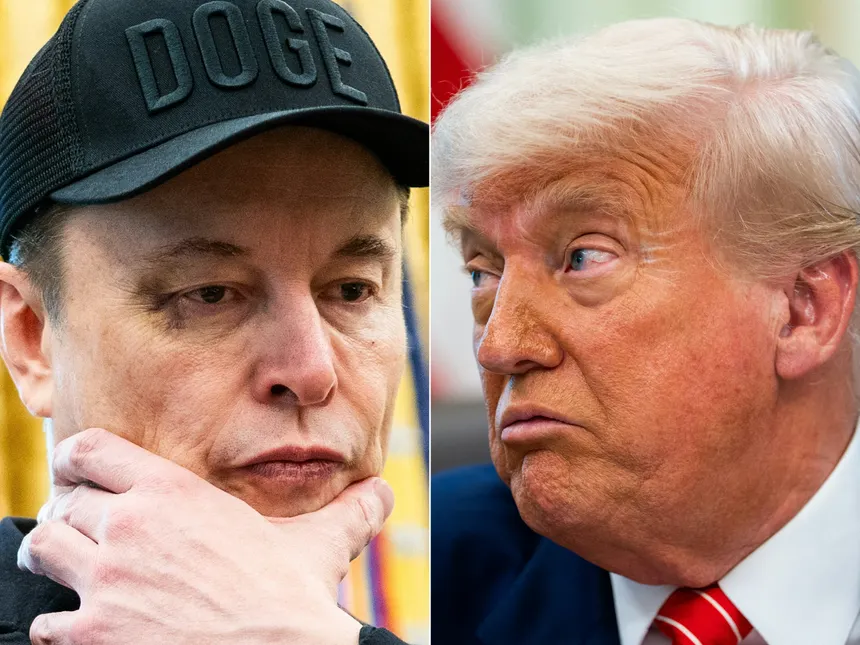Okay, let me level with you. I’ve spent the last decade as a legal compliance officer for a mid-sized tech firm. It wasn’t exactly glamorous – a lot of spreadsheets, endless policy reviews, and the occasional late-night scramble to explain why we couldn’t send GIFs of dancing hamsters to hostile foreign governments. But it *was* a crash course in how power, money, and public perception collide, especially when you’re dealing with individuals who operate outside the usual playbook. And honestly? Watching the dynamic between Donald Trump and Elon Musk has been… fascinating, bewildering, and, if I’m being entirely honest, a little concerning. It feels like front-row seats to a political Wild West, and I wanted to break down why, beyond the headlines and Twitter storms, this whole thing is a complicated mess.
I’m not here to offer my opinion on either guy – that’s not my job, and frankly, it’s a minefield. Instead, I want to focus on what I’ve learned about the *process* of navigating these incredibly high-stakes relationships, particularly when they start to tangle with legal issues and serious allegations. Because let’s be clear: this isn’t just about two billionaires liking each other’s tweets. This is about potential legal liabilities, public relations disasters, and a weird, blurry line between legitimate business dealings and, well, something else.
**The Brokerage Connection: Where the Murk Begins**
The initial thread connecting Trump and Musk, and the one that immediately grabbed the attention of the legal world and the media, was the unusual involvement of Stephen Baldwin’s brokerage firm, Baldwin Rock Creek, in facilitating communications between Trump and Peter Navarro, a former trade advisor to the Trump administration who was facing an ethics investigation related to Huawei. Navarro was allegedly pushing for a secret deal with China, and Baldwin Rock Creek was tasked with finding a way to connect him with Trump, seemingly without the full knowledge or approval of the Trump team.
Now, look, I’ve dealt with a lot of potential conflicts of interest in my career. Compliance is built on identifying and mitigating *those* – situations where someone’s personal interests could compromise their professional duties. What happened here felt… blatant. It wasn’t just about a client wanting to talk to a former president; it was about a firm knowingly facilitating communication in a way that could be construed as skirting legal boundaries and potentially obstructing an investigation.
My immediate thought, as a compliance officer, was: “How did this *not* get flagged?” The fact that this went under the radar for so long is astounding. It underscores a serious problem – relying solely on the good faith of individuals involved. You can’t just assume people are acting ethically, especially when enormous sums of money are potentially involved. You *need* robust systems, clear policies, and people who are willing to speak up when something feels wrong.
Baldwin Rock Creek’s actions weren’t illegal *per se* – they weren’t explicitly breaking any laws, at least not initially. But it created a massive gray area. The legal maneuverings were incredibly careful, designed to avoid direct involvement and potential liability. The fact that the firm was essentially acting as a private courier for sensitive information, without a full understanding of the broader context, is what raised serious red flags. It’s a classic example of a situation where seemingly innocuous actions can quickly escalate into something far more complicated.
**Navigating the Legal Maze: A Game of Smoke and Mirrors?**
Following the initial reporting, investigations began. It’s been a slow dance, with a lot of denials, obfuscation, and legal maneuvering. Baldwin Rock Creek claimed they were just “facilitating communications” at the request of a client, and that they had no knowledge of the specific investigation into Navarro. Trump himself dismissed it as a “witch hunt” – a familiar refrain, of course.
What’s become apparent is that the legal strategy hasn’t been about proving wrongdoing, but about establishing plausible deniability. They’ve pointed to the lack of a formal contract, the vague nature of the instructions they received, and the assertion that they were acting solely as a messenger. But the sheer volume of emails, the documented timelines, and the very nature of the communications strongly suggest a more deliberate and orchestrated effort.
This isn’t a simple case, and it’s unlikely to be resolved quickly. The legal arguments are complex, and the evidence is fragmented. But it highlights a crucial point: when powerful individuals are involved, the legal system can be a slow, frustrating, and opaque process. The presumption of innocence is important, but it doesn’t automatically mean actions are justified simply because someone hasn’t been formally charged.
From a compliance perspective, the whole situation is a masterclass in risk management – or, perhaps more accurately, a cautionary tale about how *not* to handle sensitive communications. The lack of due diligence, the failure to properly vet the client’s requests, and the apparent reluctance to ask critical questions created a perfect storm for potential legal trouble.
**The Media Frenzy: Amplifying the Drama**
Of course, the whole thing wouldn’t be nearly as prominent without the media. The coverage has been relentless, fueled by social media outrage and a healthy dose of speculation. It’s been fascinating (and frankly exhausting) to watch the different narratives emerge and how they’ve been shaped and reshaped by various news outlets.
The media’s role is complicated. On one hand, they have a responsibility to investigate and report on matters of public interest, and the potential legal and ethical implications of this case certainly qualify. On the other hand, the constant focus on Trump and Musk – and the sensationalism that often accompanies this kind of coverage – can overshadow the more nuanced legal realities.
I’ve seen firsthand how quickly a story can spiral out of control when it’s amplified by social media. Facts get distorted, opinions are presented as facts, and the public is bombarded with a constant stream of emotionally charged commentary. It’s incredibly difficult to cut through the noise and get to the truth.
The media’s approach, in my opinion, sometimes prioritizes clicks and engagement over accuracy and context. The constant framing of this as a “Trump-Musk drama” risks reducing a complex legal and ethical situation to a personality-driven spectacle. It’s important to remember that these are real people with real legal risks, and the media’s responsibility is to report the facts responsibly, not to simply amplify the drama.
**Beyond the Brokerage: A Pattern of Behavior?**
The Baldwin Rock Creek episode isn’t an isolated incident. It raises broader questions about the strategies employed by Trump and Musk – and their associates – when navigating legal and political challenges. There’s a discernible pattern here, characterized by:
* **Reliance on ‘Trusted’ Advisors:** Both Trump and Musk frequently rely on a small circle of advisors who seem to operate largely outside of traditional legal channels. These advisors are often entrusted with sensitive information and tasked with carrying out strategic initiatives, but their loyalty isn’t always clear, and their judgment isn’t always sound.
* **Use of Private Communications:** Both men have a penchant for using private messaging platforms – Signal, Telegram, and others – to communicate with each other and with their supporters. This creates a significant challenge for investigators, as it makes it difficult to access and analyze the full scope of their communications.
* **Aggressive Denialism:** When confronted with allegations or scrutiny, both Trump and Musk tend to employ aggressive denialism and personal attacks. This tactic, while effective in rallying their base, can also hinder the pursuit of truth and accountability.
* **Exploitation of Legal Loopholes:** There’s a consistent pattern of using complex legal structures and strategies to shield themselves from liability and avoid scrutiny. This isn’t necessarily illegal, but it raises questions about transparency and ethical conduct.
It’s not about painting either man as inherently corrupt. It’s about recognizing that operating at this level of influence requires a willingness to take risks – and to exploit ambiguities in the law.
**The Musk-Ukraine Deal: A Different Kind of Controversy**
Let’s shift gears slightly, because the Trump-Musk dynamic isn’t solely defined by the Baldwin Rock Creek situation. The recent controversy surrounding Musk’s involvement in facilitating a potential military aid package for Ukraine has added another layer of complexity to the narrative.
Reports emerged that Musk had contacted the Biden administration to offer Starlink satellite internet service to Ukraine, potentially bypassing congressional approval for direct military aid. While seemingly a benevolent act on the surface – bolstering Ukraine’s defense capabilities – the move sparked intense debate and raised concerns about Musk’s influence on foreign policy decisions.
From a compliance standpoint, this raises numerous issues. While providing humanitarian aid is generally acceptable, the suggestion of bypassing established legal processes and potentially undermining congressional authority is problematic. There’s a delicate balance between private philanthropy and exerting undue influence on government policy.
The way Musk presented this offer – framing it as a simple private initiative – felt intentionally misleading. It wasn’t just a charitable gesture; it was a calculated attempt to shape the narrative around the aid package and potentially influence the outcome of a critical debate in Congress. This kind of maneuvering is precisely what compliance programs are designed to prevent—the subtle blurring of lines between personal action and public policy.
Adding to the complexity is Musk’s own history of erratic behavior and impulsive decision-making. His tendency to announce ambitious projects on Twitter without fully considering the logistical or financial implications has repeatedly created problems for his companies. This pattern of behavior raises questions about his judgment and his willingness to accept responsibility for the consequences of his actions.
**Trust and Due Diligence: Lessons Learned**
Looking back on this whole saga – the Baldwin Rock Creek episode, the Musk-Ukraine deal, and everything in between – it’s clear that trust and due diligence are paramount, especially when dealing with high-profile individuals and complex legal issues.
In my previous role, we had strict protocols for verifying the identities of our clients, assessing potential conflicts of interest, and ensuring that all communications were properly documented. These protocols weren’t designed to stifle business, but to protect the company from legal liability and maintain ethical standards.
The lesson here is that you can’t just assume that everyone is acting with good intentions. You need to be proactive in identifying and mitigating risks – and that requires a culture of transparency, accountability, and a willingness to challenge assumptions.
It’s also important to remember that silence can be just as damaging as wrongdoing. Individuals who witness questionable behavior have a responsibility to speak up – even if it’s uncomfortable or risky. A culture of fear can create an environment where wrongdoing thrives, while a culture of openness can help to prevent it.
**The Future of These Relationships**
Predicting the future of Trump and Musk’s relationship is, frankly, impossible. They’re both driven by ambition, ego, and a deep-seated distrust of established institutions. They seem to thrive on controversy and are willing to take enormous risks to achieve their goals.
However, the legal challenges they face – and the ongoing scrutiny from the media – are undoubtedly creating friction. It’s likely that these issues will continue to be a source of tension for years to come.
One thing is certain: the way they navigate these challenges will have a significant impact on their reputations, their businesses, and the broader political landscape.
As someone who’s spent years analyzing legal compliance and navigating the complexities of corporate governance, I can tell you that this is a situation that requires careful monitoring and a healthy dose of skepticism. There’s a lot going on behind the scenes – a lot of maneuvering, obfuscation, and strategic posturing.
And frankly, it’s a reminder that even in the 21st century, the rules of the game – and the potential consequences of breaking them – still apply. It’s a fascinating, and somewhat unsettling, glimpse into the intersection of power, money, and the law.
—
Do you want me to expand on any particular aspect of this blog post, maybe delve deeper into a specific legal issue, or explore a different angle?
Sourashis Chanda brings readers their unique perspective on Business, Economy, Health and Fitness. With a background in Health and Physical Fitness of 2years, I am dedicated to exploring [what they aim to achieve with their writing, on the sustainable Economy of the country, various pro tips about business, latest goverment news, with some tips in health are and Fitness.







